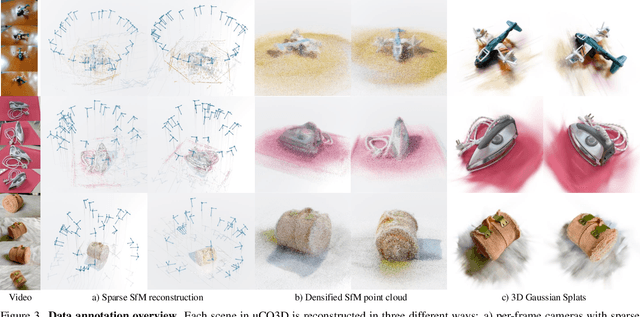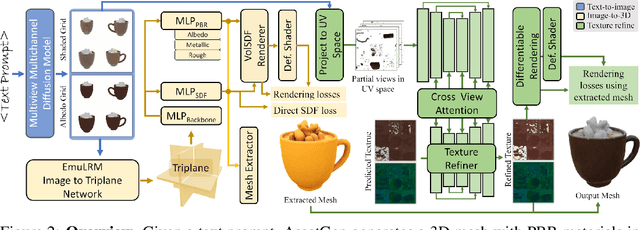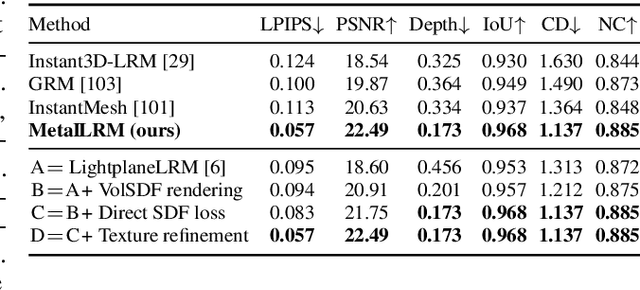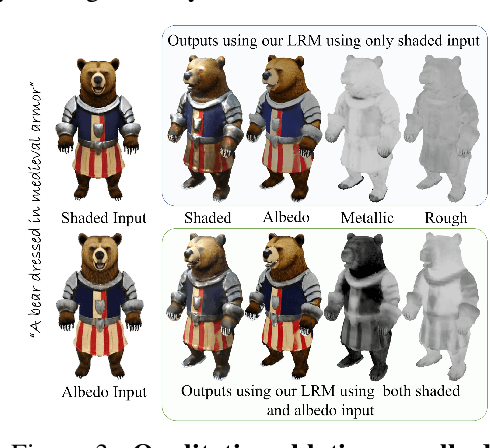David Novotny
WildCAT3D: Appearance-Aware Multi-View Diffusion in the Wild
Jun 16, 2025Abstract:Despite recent advances in sparse novel view synthesis (NVS) applied to object-centric scenes, scene-level NVS remains a challenge. A central issue is the lack of available clean multi-view training data, beyond manually curated datasets with limited diversity, camera variation, or licensing issues. On the other hand, an abundance of diverse and permissively-licensed data exists in the wild, consisting of scenes with varying appearances (illuminations, transient occlusions, etc.) from sources such as tourist photos. To this end, we present WildCAT3D, a framework for generating novel views of scenes learned from diverse 2D scene image data captured in the wild. We unlock training on these data sources by explicitly modeling global appearance conditions in images, extending the state-of-the-art multi-view diffusion paradigm to learn from scene views of varying appearances. Our trained model generalizes to new scenes at inference time, enabling the generation of multiple consistent novel views. WildCAT3D provides state-of-the-art results on single-view NVS in object- and scene-level settings, while training on strictly less data sources than prior methods. Additionally, it enables novel applications by providing global appearance control during generation.
LIM: Large Interpolator Model for Dynamic Reconstruction
Mar 28, 2025



Abstract:Reconstructing dynamic assets from video data is central to many in computer vision and graphics tasks. Existing 4D reconstruction approaches are limited by category-specific models or slow optimization-based methods. Inspired by the recent Large Reconstruction Model (LRM), we present the Large Interpolation Model (LIM), a transformer-based feed-forward solution, guided by a novel causal consistency loss, for interpolating implicit 3D representations across time. Given implicit 3D representations at times $t_0$ and $t_1$, LIM produces a deformed shape at any continuous time $t\in[t_0,t_1]$, delivering high-quality interpolated frames in seconds. Furthermore, LIM allows explicit mesh tracking across time, producing a consistently uv-textured mesh sequence ready for integration into existing production pipelines. We also use LIM, in conjunction with a diffusion-based multiview generator, to produce dynamic 4D reconstructions from monocular videos. We evaluate LIM on various dynamic datasets, benchmarking against image-space interpolation methods (e.g., FiLM) and direct triplane linear interpolation, and demonstrate clear advantages. In summary, LIM is the first feed-forward model capable of high-speed tracked 4D asset reconstruction across diverse categories.
VGGT: Visual Geometry Grounded Transformer
Mar 14, 2025Abstract:We present VGGT, a feed-forward neural network that directly infers all key 3D attributes of a scene, including camera parameters, point maps, depth maps, and 3D point tracks, from one, a few, or hundreds of its views. This approach is a step forward in 3D computer vision, where models have typically been constrained to and specialized for single tasks. It is also simple and efficient, reconstructing images in under one second, and still outperforming alternatives that require post-processing with visual geometry optimization techniques. The network achieves state-of-the-art results in multiple 3D tasks, including camera parameter estimation, multi-view depth estimation, dense point cloud reconstruction, and 3D point tracking. We also show that using pretrained VGGT as a feature backbone significantly enhances downstream tasks, such as non-rigid point tracking and feed-forward novel view synthesis. Code and models are publicly available at https://github.com/facebookresearch/vggt.
Twinner: Shining Light on Digital Twins in a Few Snaps
Mar 11, 2025Abstract:We present the first large reconstruction model, Twinner, capable of recovering a scene's illumination as well as an object's geometry and material properties from only a few posed images. Twinner is based on the Large Reconstruction Model and innovates in three key ways: 1) We introduce a memory-efficient voxel-grid transformer whose memory scales only quadratically with the size of the voxel grid. 2) To deal with scarcity of high-quality ground-truth PBR-shaded models, we introduce a large fully-synthetic dataset of procedurally-generated PBR-textured objects lit with varied illumination. 3) To narrow the synthetic-to-real gap, we finetune the model on real life datasets by means of a differentiable physically-based shading model, eschewing the need for ground-truth illumination or material properties which are challenging to obtain in real life. We demonstrate the efficacy of our model on the real life StanfordORB benchmark where, given few input views, we achieve reconstruction quality significantly superior to existing feedforward reconstruction networks, and comparable to significantly slower per-scene optimization methods.
UnCommon Objects in 3D
Jan 13, 2025



Abstract:We introduce Uncommon Objects in 3D (uCO3D), a new object-centric dataset for 3D deep learning and 3D generative AI. uCO3D is the largest publicly-available collection of high-resolution videos of objects with 3D annotations that ensures full-360$^{\circ}$ coverage. uCO3D is significantly more diverse than MVImgNet and CO3Dv2, covering more than 1,000 object categories. It is also of higher quality, due to extensive quality checks of both the collected videos and the 3D annotations. Similar to analogous datasets, uCO3D contains annotations for 3D camera poses, depth maps and sparse point clouds. In addition, each object is equipped with a caption and a 3D Gaussian Splat reconstruction. We train several large 3D models on MVImgNet, CO3Dv2, and uCO3D and obtain superior results using the latter, showing that uCO3D is better for learning applications.
PartGen: Part-level 3D Generation and Reconstruction with Multi-View Diffusion Models
Dec 24, 2024



Abstract:Text- or image-to-3D generators and 3D scanners can now produce 3D assets with high-quality shapes and textures. These assets typically consist of a single, fused representation, like an implicit neural field, a Gaussian mixture, or a mesh, without any useful structure. However, most applications and creative workflows require assets to be made of several meaningful parts that can be manipulated independently. To address this gap, we introduce PartGen, a novel approach that generates 3D objects composed of meaningful parts starting from text, an image, or an unstructured 3D object. First, given multiple views of a 3D object, generated or rendered, a multi-view diffusion model extracts a set of plausible and view-consistent part segmentations, dividing the object into parts. Then, a second multi-view diffusion model takes each part separately, fills in the occlusions, and uses those completed views for 3D reconstruction by feeding them to a 3D reconstruction network. This completion process considers the context of the entire object to ensure that the parts integrate cohesively. The generative completion model can make up for the information missing due to occlusions; in extreme cases, it can hallucinate entirely invisible parts based on the input 3D asset. We evaluate our method on generated and real 3D assets and show that it outperforms segmentation and part-extraction baselines by a large margin. We also showcase downstream applications such as 3D part editing.
Meta 3D Gen
Jul 02, 2024



Abstract:We introduce Meta 3D Gen (3DGen), a new state-of-the-art, fast pipeline for text-to-3D asset generation. 3DGen offers 3D asset creation with high prompt fidelity and high-quality 3D shapes and textures in under a minute. It supports physically-based rendering (PBR), necessary for 3D asset relighting in real-world applications. Additionally, 3DGen supports generative retexturing of previously generated (or artist-created) 3D shapes using additional textual inputs provided by the user. 3DGen integrates key technical components, Meta 3D AssetGen and Meta 3D TextureGen, that we developed for text-to-3D and text-to-texture generation, respectively. By combining their strengths, 3DGen represents 3D objects simultaneously in three ways: in view space, in volumetric space, and in UV (or texture) space. The integration of these two techniques achieves a win rate of 68% with respect to the single-stage model. We compare 3DGen to numerous industry baselines, and show that it outperforms them in terms of prompt fidelity and visual quality for complex textual prompts, while being significantly faster.
Meta 3D AssetGen: Text-to-Mesh Generation with High-Quality Geometry, Texture, and PBR Materials
Jul 02, 2024



Abstract:We present Meta 3D AssetGen (AssetGen), a significant advancement in text-to-3D generation which produces faithful, high-quality meshes with texture and material control. Compared to works that bake shading in the 3D object's appearance, AssetGen outputs physically-based rendering (PBR) materials, supporting realistic relighting. AssetGen generates first several views of the object with factored shaded and albedo appearance channels, and then reconstructs colours, metalness and roughness in 3D, using a deferred shading loss for efficient supervision. It also uses a sign-distance function to represent 3D shape more reliably and introduces a corresponding loss for direct shape supervision. This is implemented using fused kernels for high memory efficiency. After mesh extraction, a texture refinement transformer operating in UV space significantly improves sharpness and details. AssetGen achieves 17% improvement in Chamfer Distance and 40% in LPIPS over the best concurrent work for few-view reconstruction, and a human preference of 72% over the best industry competitors of comparable speed, including those that support PBR. Project page with generated assets: https://assetgen.github.io
Lightplane: Highly-Scalable Components for Neural 3D Fields
Apr 30, 2024



Abstract:Contemporary 3D research, particularly in reconstruction and generation, heavily relies on 2D images for inputs or supervision. However, current designs for these 2D-3D mapping are memory-intensive, posing a significant bottleneck for existing methods and hindering new applications. In response, we propose a pair of highly scalable components for 3D neural fields: Lightplane Render and Splatter, which significantly reduce memory usage in 2D-3D mapping. These innovations enable the processing of vastly more and higher resolution images with small memory and computational costs. We demonstrate their utility in various applications, from benefiting single-scene optimization with image-level losses to realizing a versatile pipeline for dramatically scaling 3D reconstruction and generation. Code: \url{https://github.com/facebookresearch/lightplane}.
Animal Avatars: Reconstructing Animatable 3D Animals from Casual Videos
Mar 25, 2024Abstract:We present a method to build animatable dog avatars from monocular videos. This is challenging as animals display a range of (unpredictable) non-rigid movements and have a variety of appearance details (e.g., fur, spots, tails). We develop an approach that links the video frames via a 4D solution that jointly solves for animal's pose variation, and its appearance (in a canonical pose). To this end, we significantly improve the quality of template-based shape fitting by endowing the SMAL parametric model with Continuous Surface Embeddings, which brings image-to-mesh reprojection constaints that are denser, and thus stronger, than the previously used sparse semantic keypoint correspondences. To model appearance, we propose an implicit duplex-mesh texture that is defined in the canonical pose, but can be deformed using SMAL pose coefficients and later rendered to enforce a photometric compatibility with the input video frames. On the challenging CoP3D and APTv2 datasets, we demonstrate superior results (both in terms of pose estimates and predicted appearance) to existing template-free (RAC) and template-based approaches (BARC, BITE).
 Add to Chrome
Add to Chrome Add to Firefox
Add to Firefox Add to Edge
Add to Edge